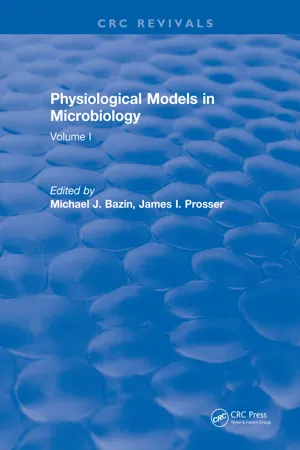
This is a test
- 150 pages
- English
- ePUB (mobile friendly)
- Available on iOS & Android
eBook - ePub
Book details
Book preview
Table of contents
Citations
About This Book
Physiological Models in Microbiology consists of two volumes. Volume I considers models of basic growth processes and the effects of environmental factors on microbial growth. Volume II describes models of secondary processes, in particular, microbial death, spore germination, chemotaxis, and surface growth.
Frequently asked questions
At the moment all of our mobile-responsive ePub books are available to download via the app. Most of our PDFs are also available to download and we're working on making the final remaining ones downloadable now. Learn more here.
Both plans give you full access to the library and all of Perlego’s features. The only differences are the price and subscription period: With the annual plan you’ll save around 30% compared to 12 months on the monthly plan.
We are an online textbook subscription service, where you can get access to an entire online library for less than the price of a single book per month. With over 1 million books across 1000+ topics, we’ve got you covered! Learn more here.
Look out for the read-aloud symbol on your next book to see if you can listen to it. The read-aloud tool reads text aloud for you, highlighting the text as it is being read. You can pause it, speed it up and slow it down. Learn more here.
Yes, you can access Physiological Models in Microbiology by M. Bazin in PDF and/or ePUB format, as well as other popular books in Biological Sciences & Microbiology. We have over one million books available in our catalogue for you to explore.
Information
Chapter 1
Regulation and Control of Metabolic Pathways
H. Kacser
Table of Contents
- I. Introduction
- II. The Control Coefficients
- A. Definitions
- B. The Summation Properties
- C. Experimental Estimates
- III. The Elasticity Coefficients
- A. The Connectivity Properties
- IV. Negative Feedback
- V. Growing Systems
- A. The Steady State
- VI. Conclusion
- References
I. Introduction
In addressing the problems of control of metabolism in microorganisms it is useful to distinguish universal aspects, those that are common to all living systems, and specific aspects, those that are unique, or at least overwhelmingly represented, in cellular types. The universal aspects are represented by pathways and their enzymes leading to the production of energy, proteins, nucleic acids, "waste" products, and so on. There are, of course, differences between species, not only in the absence or presence of particular enzymes, but also in whole pathways and even complete areas of metabolic activity. We shall not discuss these differences, which are the proper concern of comparative biochemistry and evolution. The broad organization of any cell is sufficiently similar to any other that we can talk about the cell and use the information from studies in the field of biochemistry.
There are, however, some properties of microorganisms which largely set them apart These are connected with the fact that microorganisms spend most or a most important part of their "life" in reproducing asexually or growing. As we shall see, this does affect their control properties. There are other differences, such as the absence of tissues and organs, which in some sense makes the analysis simpler, but in other ways has resulted in the development of mechanisms which are more elaborate.
We shall start by considering the cell and what universal features we can discern. The first is that the individual chemical transformations, which constitute the units of activity, are organized. This organization is not so much a spatial one, although this does exist, but is kinetic in nature. It results from the...
Table of contents
- Cover
- Title
- Copyright
- PREFACE
- THE EDITORS
- CONTRIBUTORS
- Contents
- Chapter 1 Regulation and Control of Metabolic Pathways
- Chapter 2 A Thermodynamic View of Bacterial Growth
- Chapter 3 Steady State Kinetic Analysis of Chemiosmotic Proton Circuits in Microorganisms
- Chapter 4 Temperature Effects on Bacterial Growth Rates
- Chapter 5 Population Growth Kinetics of Photosynthetic Microorganisms
- Chapter 6 Role of pH in Biological Waste Water Treatment Processes
- Index